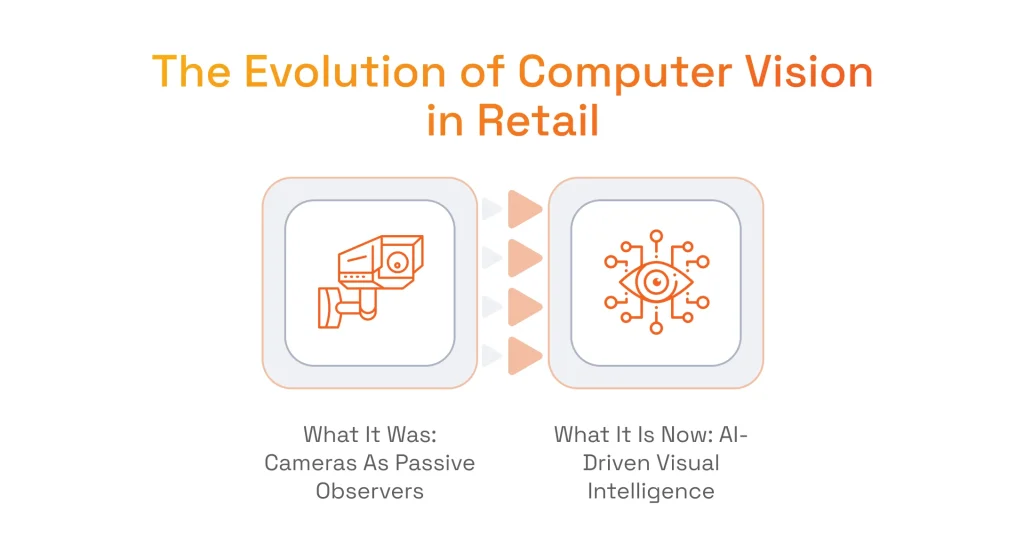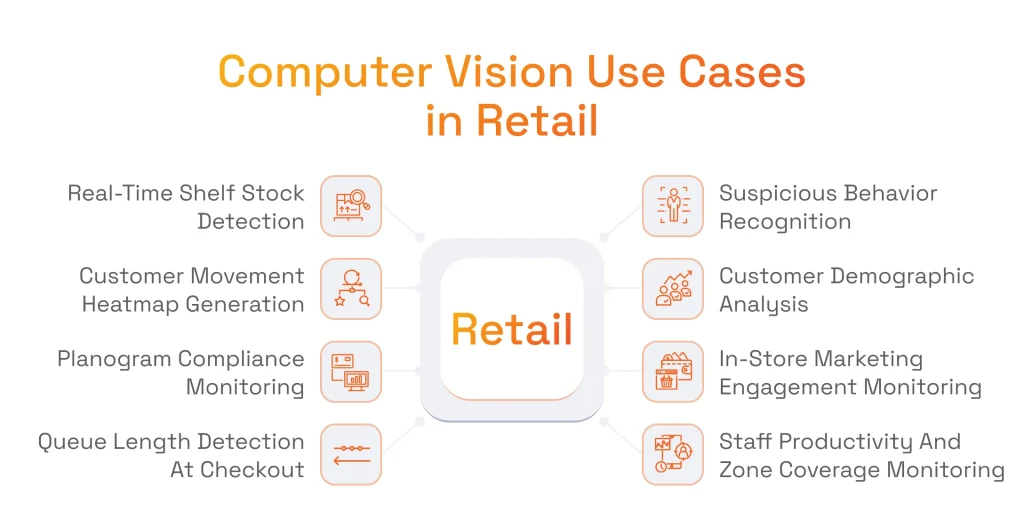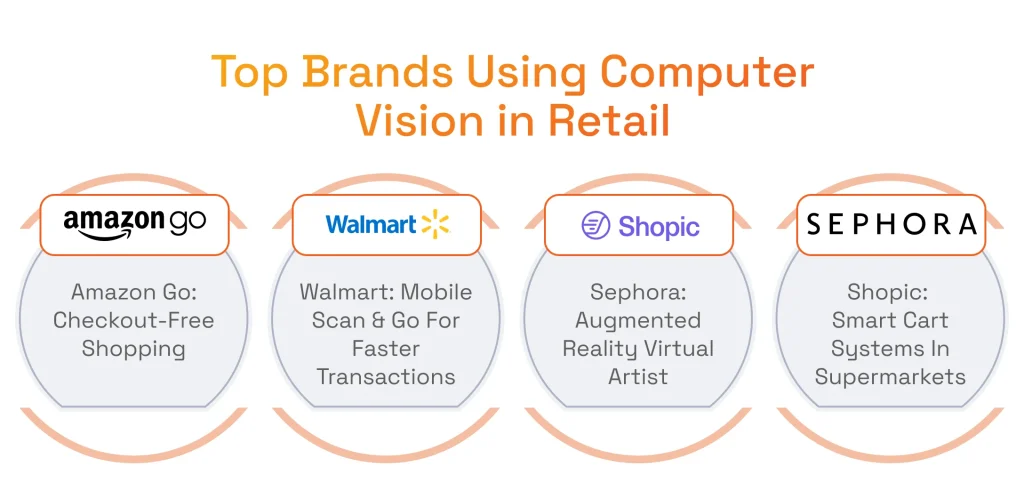The modern retail landscape is riddled with blind spots that cost money every single day. Store managers struggle with out-of-stock shelves they don’t know about until customers complain. Marketing teams guess at customer behavior instead of seeing actual shopping patterns. Security teams react to theft after it happens, not before. Meanwhile, competitors are turning these same challenges into competitive advantages using computer vision technology (or, machine vision in retail).
Computer vision is fundamentally changing retail by transforming passive camera systems into intelligent business tools that deliver real-time insights, automate operations, and enhance customer experiences. This technology converts visual data from store cameras into actionable intelligence that drives everything from inventory management to personalized shopping experiences. In this article, we’ll explore how computer vision in retail industry creates measurable business value, examine specific use cases that are reshaping retail operations, and look at how leading brands are already seeing results from strategic implementation.
Why Computer Vision in Retail Is Not Just About Cameras
Computer vision in retail has evolved dramatically beyond mere surveillance. It’s no longer just about cameras passively recording footage; instead, it’s about leveraging AI to transform visual data into actionable intelligence. Let’s quickly recap how retailers used cameras in the past, and what outputs computer vision provides today.

What It Was: Cameras as Passive Observers
In former times, a camera was hanging in the corner of a store, silently recording grainy footage 24/7. Someone had to manually scrub through hours of tape to find clues if something went missing or a customer complained. These systems were reactive — like a detective showing up after the crime. They helped solve problems but didn’t prevent them. Such a state of play resulted in:
- Security-only capabilities. Cameras were there to catch shoplifters, not boost sales.
- Manual labor required. Employees wasted hours reviewing footage instead of helping customers.
- Missed opportunities. No real-time insights into customer behavior or operational hiccups.
Back then, cameras were like expensive note-takers — they documented events but couldn’t act on them.
What It Is Now: AI-Driven Visual Intelligence
Today’s computer vision isn’t your grandma’s CCTV. It’s like giving cameras a brain, eyes, and a megaphone. Modern AI for retail doesn’t just watch — it understands what’s happening and shouts actionable insights to your team in real time.
Here’s how it works:
- Real-time alerts. Empty shelf? The system pings staff before customers notice. Suspicious behavior? Security gets a heads-up instantly.
- Google Analytics for your store. Track foot traffic, dwell times, and product interactions like you’d track website clicks.
- Seamless integrations. Syncs with your POS, inventory apps, and employee schedules to turn raw data into smart decisions.
With AI and IoT, cameras are no longer passive — they’re active team members driving profits.
Serhii Leleko
ML & AI Engineer at SPD Technology
“Based on our completed projects, we know how AIoT can benefit enterprise-level companies, while at the same time, it can be applicable and beneficial for businesses of any scale.”
Transformative Benefits of Using Computer Vision for Retail
Let’s talk about the benefits of computer vision for retail. It transforms the industry by delivering tangible advantages across various operations. Here’s a list of key and advanced computer vision capabilities that are driving a new era of efficiency and strategic insight in the retail industry.

Higher Accuracy in Store Operations
Imagine never worrying about misplaced products or incorrect price tags again. Computer vision acts like a supercharged set of eyes, scanning shelves 24/7 to catch inventory mismatches before they annoy customers. Systems can identify specific products, track their placement, and verify planogram compliance without requiring staff to inspect every aisle physically. This isn’t just about accuracy — it frees your team to focus on helping shoppers, not chasing down stockroom mysteries.
Faster, Real-Time Decision-Making
Why wait for a monthly report when you can act in real time? Cameras with built-in AI analyze checkout lines, shelf stock, and even customer moods as they happen. Managers get a ping to open another register if the queue gets too long. If a high-value item goes missing, security gets alerted. It’s like having a crystal ball that shows you exactly where to focus — right now.
Reduced Shrinkage and Loss Prevention
Thieves used to count on busy staff missing their tricks. Not anymore. AI watches for subtle red flags — like someone lingering too long in the electronics aisle or stuffing items into a bag. Rather than simply recording theft for later investigation, these systems can:
- Alert security in real-time to potential incidents.
- Identify repeat offenders automatically.
- Track unusual product movement patterns.
- Reduce false alarms through sophisticated behavior analysis.
Even better: these systems work discreetly, so honest customers never feel like they’re in a spy movie.
Enhanced In-Store Customer Experience
Picture this: a customer walks into your store, and a digital display recommends products based on their age or style. No more guessing games — with computer vision, retail shops personalize the experience, making shoppers feel seen. Bonus? Shorter checkout waits keep frustration levels low and loyalty high.
Serhii Leleko
ML & AI Engineer at SPD Technology
“Retail is all about understanding your customers and anticipating their needs. It always was, but businesses are better equipped with data now. We’re not just talking about numbers; we’re talking about turning those numbers into an actionable checklist.”
More Informed Business Strategy
Heatmaps showing where customers linger. Dwell times on your new product display. Demographics of who’s buying what. This isn’t just data — it’s your playbook for smarter merchandising.
With computer vision, retailers no longer rely on guesswork or delayed reports. Instead, they gain instant insights into shopper behavior, store traffic flows, and product engagement. This enables faster, evidence-based decisions on everything from shelf placement to cross-promotions.
Improved Profitability
Automated inventory checks cut labor costs by up to 20-30%. Faster checkouts mean you can serve more customers with the same staff. And when you nail personalization (like H&M’s virtual try-on mirrors), basket sizes grow. It’s not magic — it’s math. Computer vision, retail analytics — they turn small efficiencies into big profits.
Better Omnichannel Integration
Do your shoppers browse online but buy in-store? Computer vision connects the dots. If someone spends time at your in-store makeup counter, send them a digital coupon for that brand later. Or use heatmap data to replicate your best physical layouts on your website. With generative AI in eCommerce, you can create personalized recommendations automatically. It’s like giving your customers a seamless experience, whether they’re holding a phone or a shopping cart.
Computer Vision Use Cases in Retail
Computer vision provides retailers a broad spectrum of solutions, from optimizing inventory and store layouts to enhancing security and personalizing customer experiences. Let’s explore some specific computer vision and ML use cases in retail.

Real-Time Shelf Stock Detection
No more “Sorry, we’re out of stock” moments. AI cameras scan shelves every 15 minutes, alerting staff the second a popular item runs low. This kind of automation ensures shelves stay replenished without manual checks, reducing missed sales opportunities and improving customer satisfaction. It also helps prioritize restocking efforts, so your team focuses on what truly matters — keeping high-demand products visible and available.
Heatmap Generation of Customer Movement
Foot traffic analysis tools create visual maps of shopper pathways, highlighting high-engagement zones. Retailers use this data to reposition products or adjust aisle widths, increasing exposure for underperforming items. Strategic zoning, the placement of impulse areas, and the emotional impact of design elements all contribute to this invisible choreography. Heatmaps show exactly where shoppers cluster. It’s like Google Analytics for your floor plan.
Planogram Compliance Monitoring
Messed-up product displays can kill sales. AI verifies that products align with predefined planograms, ensuring optimal shelf layouts. Cameras detect deviations, such as incorrect facings or promotional tag placements, and notify staff about corrections. This maintains brand consistency and maximizes sales potential, as 82% of purchasing decisions occur in-store.
Queue Length Detection at Checkout
Long waits = lost customers. AI monitors queue lengths and tells managers when to open new registers. Retailers reduce average wait times using real-time queue analytics, improving customer satisfaction scores, and turning grumpy shoppers into repeat buyers.
Suspicious Behavior Recognition
Predicting customer behavior with AI capabilities brings theft prevention to the next level. That guy nervously glancing around the perfume counter? The system flags him. A group loitering near high-theft items? Security gets a quiet alert. Stores using this tech report up to 40% fewer theft incidents, protecting both profits and shopper safety. Such computer vision systems based on deep learning models also anonymize data to comply with privacy regulations, balancing security and customer trust.
Customer Demographic Analysis
Facial recognition and motion tracking classify shoppers by age, gender, and mood, enabling targeted marketing. Beauty brands use demographic data to display age-specific skincare ads on digital screens, increasing click-through rates. This personalization mirrors online tactics, strengthening brands’ loyalty.
Monitoring of In-Store Marketing Engagement
Did anyone notice your new endcap display? Computer vision tracks how long people look at it or if they pick up products. These insights reveal which campaigns truly capture attention — and which ones don’t. You’ll know whether your in-store signage drives interaction or gets ignored, helping you fine-tune messaging, placement, and design.
Staff Productivity and Zone Coverage Monitoring
Are cashiers stuck restocking instead of assisting customers? AI tracks staff movements and suggests better tasks. Computer vision helps optimize workforce management by monitoring staff presence and productivity across different store zones. AI-powered systems can:
- Track staff coverage in high-priority areas.
- Identify zones that receive insufficient attention.
- Monitor response times to customer service needs.
- Analyze the correlation between staff presence and sales performance.
- Optimize shift scheduling based on customer traffic patterns.
Through these organizational improvements, AI transforms customer service. Happy employees + happy customers = win-win.
Computer Vision in Retail for Product Interaction Tracking
Understanding how customers interact with products before purchasing provides crucial insights for inventory management and marketing strategies. Computer vision tracks:
- Which products customers pick up and examine.
- How long customers spend evaluating different options.
- Common product comparison behaviors.
- Factors that influence final purchase decisions.
- Conversion rates from product interaction to purchase.
As you can see, computer vision use cases in retail are multifaceted. Let’s dive deeper into the computer vision applications in retail.
Looking for eCommerce development experts? See our curated list of the best eCommerce tech vendors.
Computer Vision in Retail Industry: Brands’ Stories
Now it’s time to move from description of computer vision advantages to the real-world examples of how industry-leading companies benefit from the technology.

Amazon Go
Amazon Go revolutionized retail with its “Just Walk Out” technology that combines computer vision, deep learning, and sensor fusion. Customers enter stores using the Amazon Go app, select products, and leave without traditional checkout processes. The system automatically detects selected items and charges customers’ accounts.
Key innovations:
- Ceiling-mounted cameras track customer movements and product selections.
- Weight sensors on shelves validate product removal.
- Deep learning algorithms identify products without requiring barcodes.
- Integration with payment systems enables automatic billing.
Results: Amazon Go stores demonstrate significantly reduced wait times, enhanced customer convenience, and valuable data collection on shopping behaviors that inform inventory and layout decisions.
Walmart Scan & Go
Walmart’s computer vision-powered Scan & Go app lets Sam’s Club members scan items with their smartphones as they shop, skip checkout lines, and pay via the app. The system cross-verifies products in real time, reducing errors and wait times. This frictionless experience cuts checkout time by 50% and improves customer satisfaction, while giving Walmart granular data on shopping patterns to optimize inventory and store layouts.
Sephora’s Virtual Artist
The company leverages computer vision to elevate customer experience through its Virtual Artist tool. This AI-powered feature allows customers to try on makeup virtually using smartphones or in-store tablets, creating personalized and interactive shopping experiences.
Technology features:
- Facial recognition analyzes customer features for product recommendations.
- Augmented reality enables virtual product testing.
- Integration with inventory systems shows real-time product availability.
- Customer preference data informs personalized marketing campaigns.
Business results: Sephora reports increased customer engagement, reduced product returns, and improved customer satisfaction through enhanced personalization capabilities.
Shopic’s Smart Carts
Shopic equips supermarket carts with AI clip-ons that use computer vision to automatically recognize products as customers place them in carts. The system tracks purchases in real time, detects mis-scans, and pushes personalized promotions. This eliminates traditional checkout, reduces shrinkage by 85%, and boosts sales through targeted upsells — all while requiring no store infrastructure changes.
Getting Started with Computer Vision: What to Know Before Investing
Smart technology requires smart implementation. In this section we’ll provide practical advice that addresses potential pitfalls and nuances related to integration of computer vision systems.

Computer Vision in the Retail Industry Isn’t Just for Big Brands
Many retailers assume computer vision requires massive budgets and enterprise-scale infrastructure. This misconception prevents mid-size and regional retailers from accessing technology that could significantly improve their operations.
Reality check: Modern computer vision solutions offer modular, cloud-based options that make adoption accessible for retailers of all sizes. Key considerations include:
- Start small. Focus on one specific use case, such as shelf monitoring or queue detection, rather than attempting a comprehensive deployment.
- Cloud-based processing. Reduces upfront hardware investments and enables scalable expansion.
- Subscription models. Allow predictable monthly costs instead of large capital expenditures.
- Proven ROI. Many retailers see measurable returns within 12-18 months, even with modest implementations.
Thus, the success strategy for retailers with tight budgets is to choose one high-impact use case, measure results carefully, and expand gradually based on demonstrated value.
To succeed, you don’t necessarily have to make a big jump. You can make a lot of little ones.
Strategic Integration Matters More Than Just Deployment
Installing cameras and running AI algorithms represents only the beginning of successful computer vision implementation. Real business value emerges when these systems integrate seamlessly with existing retail operations and technology infrastructure.
Critical integration points:
- Point-of-sale systems. Connect customer behavior data analytics in retail with actual purchase decisions.
- Inventory management. Link stock level monitoring with automated reordering systems.
- Workforce management. Integrate traffic patterns with staff scheduling optimization.
- Customer analytics. Combine visual insights with existing customer data platforms.
- Marketing systems. Connect behavior insights with promotional campaign management.
Key considerations:
- Evaluate current technology stack compatibility before selecting computer vision solutions.
- Plan for data flow between systems to maximize insights.
- Consider workflow changes that maximize technology benefits.
- Establish clear metrics for measuring integration success.
Success Depends on More Than the AI Model
While AI algorithms capture most attention in computer vision discussions, successful implementations require careful attention to numerous technical and operational factors that significantly impact system performance.
Critical success factors:
- Hardware placement. Camera positioning affects accuracy, coverage, and privacy compliance.
- Lighting conditions. Inconsistent or poor lighting reduces system reliability.
- Video quality. High-resolution cameras and stable network connections ensure accurate analysis.
- Data storage. Cloud vs. local storage decisions impact costs and performance.
- Privacy regulations. GDPR, CCPA, and other privacy laws affect system design and data handling.
- Environmental factors. Store layout, ceiling height, and customer traffic patterns influence system design.
Many retailers underestimate these implementation complexities and focus exclusively on AI capabilities. Successful projects require comprehensive planning that addresses technical infrastructure, operational workflows, and regulatory compliance from the beginning.
A Strategic Tech Partnership Makes the Difference
Transforming visual data into meaningful business value requires expertise that spans both technical implementation and retail operations. Most retailers benefit significantly from partnering with technology providers who understand both domains.
Essential partnership capabilities:
- Cross-functional expertise. Teams that understand AI technology and retail operations.
- Integration experience. Proven ability to connect computer vision with existing retail systems.
- Scalability planning. Capability to expand from pilot programs to multi-location deployments.
- Ongoing support: Continuous optimization and maintenance to ensure sustained performance.
Value-added services:
- Initial use case identification and ROI modeling.
- Technical infrastructure assessment and planning.
- Change management support for staff training and workflow adaptation.
- Performance monitoring and optimization recommendations.
- Regulatory compliance guidance and implementation.
Selection criteria: Choose partners with demonstrated retail industry experience, comprehensive technical capabilities, and a track record of successful multi-location deployments. Look for providers who emphasize business outcomes rather than just technical features. Finally, it’s essential to choose a tech vendor capable of providing custom AI solutions, not only pre-built ones.
Here, at SPD Technology, we excel at providing AI solutions that transform customer experience. For instance, we had developed a high-load chatbot for an online fashion store that can process 99% of queries in under 10 seconds, elevating customer service for the client.
The Bottom Line
Computer vision transforms passive surveillance cameras into AI-powered strategic tools that enhance operations, customer experience, and profitability. Retailers can now access scalable, integrated solutions tailored to their needs, overcoming myths about cost and complexity. By adopting computer vision for retail industry thoughtfully and partnering with experienced providers, the market players can unlock new levels of insight and competitive advantage.
SPD Technology is a reliable provider of computer vision development and intelligent automation services. We help retail businesses harness this transformative technology to drive smarter inventory management, optimize store operations, and elevate customer engagement. Feel free to contact us anytime for help!
FAQ
How does computer vision help with inventory management?
Computer vision for retail industry automates real-time shelf monitoring, detecting stockouts instantly and tracking inventory movement via AI cameras. It reduces manual checks while ensuring accurate stock levels.
How crucial is data security when implementing computer vision in retail?
Critical. Retailers must encrypt visual data, comply with GDPR/CCPA, and obtain customer consent to avoid breaches and maintain trust. Transparent data policies are non-negotiable.
How might computer vision impact retail jobs?
Computer vision in the retail industry shifts roles from repetitive tasks (stock checks) to tech management and customer service. Staff focus on strategy while AI handles monitoring.
